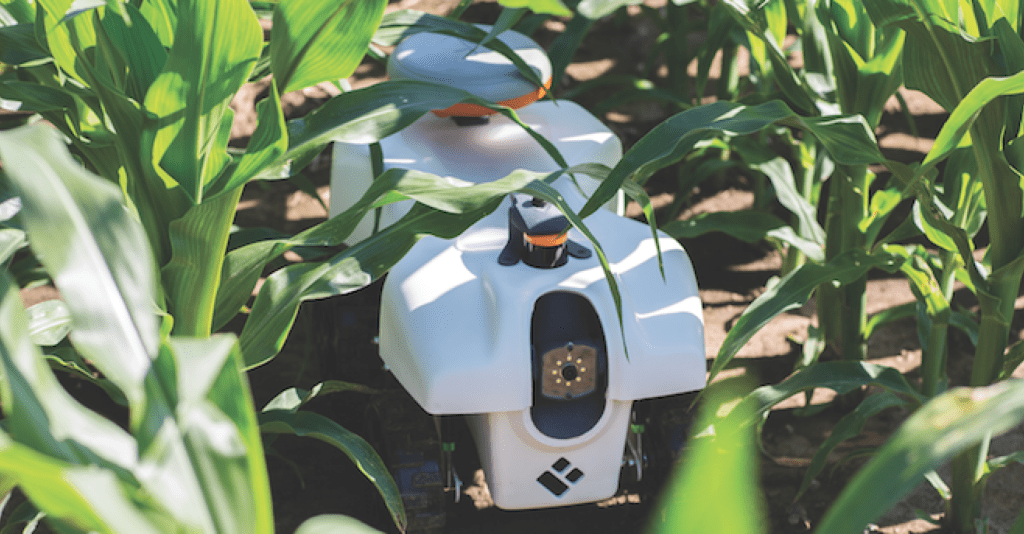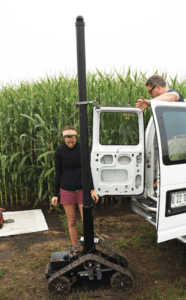
Apr 3, 2020Robot tapped for strawberry phenotyping to boost breeding
The academic developer of a robot for row crops will soon test its viability for speeding up strawberry breeding programs.
North Carolina State University (NCSU) Biological and Agricultural Engineering Assistant Professor Sierra Young said she’s looking forward to working again with TerraSentia – the commercialized version of a prototype she built as a student at the University of Illinois.
“The prototype that I helped work on and build was much different than the one that they are using now,” she said. “But that core idea of getting architecture traits and being able to have a small robot between rows stayed the same. … It’s really exciting to see how it’s progressed, and I’m really excited to use it again.”
TerraSentia (pictured above) crawls in the rows between plants where airborne drones can’t see. The early version of the robot she developed was built for phenotyping – visually checking plants in the row for desired traits. They first used it in rows of sorghum, whose leafy canopies made it difficult for airborne drones to distinguish one plant from another.
Now, a later generation of the same robot could speed up the identification of berry plants in breeding programs.

Young and her fellow researchers at NCSU, including berry breeder Gina Fernandez, will lease a TerraSentia for a variety of experiments.
“We are actually going to be getting one here and testing it out in berries,” she said. “We’ll also have to do some working with the company to expand their algorithm capabilities.”
While the robot has traditionally been focused on row crops, Young and Fernandez are interested in its applications for phenotyping strawberry and blueberry plants.
“We were thinking strawberries would be our first test case because they grow over that black plastic covering, so that makes the image analysis a little bit nicer for detecting individual fruits, their size and shape and color, and then blooms of the strawberry plants,” she said.
Berry breeding is ripe for improvement. Possibly strawberry plants in the future could be bred for more consistent canopies, canopies that could be easily harvested, she said.
As Fernandez said in a January talk at the Southeast Regional Fruit and Vegetable Conference, the primocane-bearing blackberries, as well as thornless plants, are relatively new traits that haven’t been incorporated into many varieties.
Young noted that although there is a robotic raspberry harvester being developed, it moves quite slow. Most berry patches aren’t as organized or predictable as, say, a high-density apple orchard.
“I think there are some that are farther along than others,” Young said.
But that too could change, she said.
“Another interesting component that goes along with that (robotic harvesting idea) is being able to accurately predict and even breeding some of these berry plants to have more defined harvests, and the breeding of berry plants to be more easily harvest by machines,” she said.
Strawberries and peaches
Young also spoke at Southeast Regional to update growers on robotic applications for strawberries and peaches, as well as in more general terms.
Several robotic, commercial strawberry harvesters are in development.
“There are multiple players, investors working in that space,” she said.
There are also some significant efforts in the apple industry, and Young suggested that advances in robotic apple harvesting could apply to peach growers if soft-touch robotic technology can be adapted to handle the softer peaches.
“We have all of these systems, and they’re working on all of this, but when can you be able to go to the store and get one of these to use in your own operations?” she asked. “And the answer is, who knows? We’re probably close. Is it going to be next year? No, but maybe 5-10 years.”
But she said, wrapping up a session at Southeast Regional, human growers can’t be replaced as decision-makers.
“Despite all of this automation, and all of these machines doing all of these tasks that humans might not, I still think that humans matter, whether they might be involved in a slightly different way,” she said. Humans will likely always be in the loop as decision-makers or system monitors. “In the end, we still know more than a robot does.”
— Stephen Kloosterman, associate editor
















